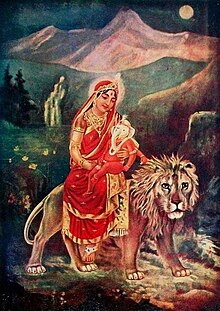
Back Parvati Afrikaans Parvati ALS بارفاتي Arabic بارفاتى ARZ পাৰ্বতী Assamese पार्वती AWA Parvati Azerbaijani Парвати Bashkir Parwati BAN Parvati BCL
| Parvati | |
|---|---|
| Member of Tridevi | |
 Parvati with her son Ganesha | |
| Other names | Uma, Gauri, Durga, Kali, Aparna, Girija, Haimavati, Shankari, Maheshvari, Ambika, Bhavani, Shivani |
| Sanskrit transliteration | Pārvatī |
| Devanagari | पार्वती |
| Affiliation | Mahadevi, Tridevi, Sati, Durga, Kali, Mahakali, Tripura Sundari, Mahavidyas |
| Abode | Mount Kailasha, Manidvipa |
| Mantra | Sarvamaṅgalamāṅgalye Śive Sarvārthasādhike। Śaranye Tryambake Gauri Nārāyaṇi Namo'Stu Te॥ |
| Day | Monday & Friday |
| Mount | Lion and Tiger |
| Texts | Devi-Bhagavata Purana, Mahabhagavata Purana, Devi Mahatmya, Kalika Purana, Shakta Upanishads, Tantras |
| Festivals | Navaratri, Vijayadashami, Teej, Bathukamma, Gauri Habba, Durga Puja, Kali Puja |
| Personal information | |
| Parents | Himavan (father) Maināvati (mother)[5][6] |
| Siblings | Vishnu (ceremonial brother) Ganga (elder sister)[3] Mainaka (elder brother)[4] |
| Consort | Shiva |
| Children | Ganesha (son) Kartikeya (son) |
| Part of a series on |
| Shaktism |
|---|
 |
|
|
Parvati (Sanskrit: पार्वती, IAST: Pārvatī), also known as Uma (Sanskrit: उमा, IAST: Umā) and Gauri (Sanskrit: गौरी, IAST: Gaurī), is the Hindu goddess of power, energy, nourishment, harmony, love, beauty, devotion, and motherhood. In her complete form, she is a physical representation of Mahadevi also known as Adi Shakti, the primordial power behind the creation of the universe, the creator and destroyer.[7][8] She is one of the central deities of the goddess-oriented sect called Shaktism, and the supreme goddess in Shaivism. Along with Lakshmi and Sarasvati, she forms the Tridevi.[9]
Parvati is the wife of Shiva. She is a primordial goddess in Hinduism.[10] Parvati and Shiva have taken many incarnations and divine forms together.[11] Parvati is the mother of the Hindu deities Ganesha and Kartikeya, Ashokasundari and many other deities. The Puranas also say that she is the companion of the river goddess Ganga, and Vishnu.[4][12] For Hindus, she is considered to be the divine energy between a man and a woman, like the energy of Shiva and Shakti.[13]
Parvati is a powerful, primordial mother goddess,[14] and also has several fearsome forms and killed evil beings in forms such as Gauri, Durga, Kali, the ten Mahavidyas, and the Navadurgas.
Parvati is an embodiment of Shakti. In Shaivism, she is the recreative energy and power of Shiva, and she is the cause of a bond that connects all beings and a means of their spiritual release.[15][16] She is also well known as Kamarupa (the embodiment of one's desires) and Kameshvari (the lordess of one's desires). In Hindu temples, shrines are dedicated to her and Shiva, she is symbolically represented as the argha. She is found extensively in ancient Indian literature, and her statues and iconography are present in Hindu temples all over South Asia and Southeast Asia.[17][18]
- ^ James D. Holt (2014). Religious Education in the Secondary School: An Introduction to Teaching, Learning and the World Religions. Routledge. p. 180. ISBN 978-1-317-69874-6.
- ^ David Kinsley (19 July 1988). Hindu Goddesses: Visions of the Divine Feminine in the Hindu Religious Tradition. University of California Press. pp. 49–50. ISBN 978-0-520-90883-3.
- ^ Siva: The Erotic Ascetic. Oxford University Press. 28 May 1981. ISBN 978-0-19-972793-3. Archived from the original on 4 April 2023. Retrieved 19 March 2023.
- ^ a b Wilkins 2001, p. 295.
- ^ C. Mackenzie Brown (1990). The Triumph of the Goddess: The Canonical Models and Theological Visions of the Devi-Bhagavata Purana. SUNY Press. ISBN 9780791403648. Archived from the original on 26 January 2024. Retrieved 20 August 2019.
- ^ Cite error: The named reference
Mainawas invoked but never defined (see the help page). - ^ H.V. Dehejia, Parvati: Goddess of Love, Mapin, ISBN 978-8185822594
- ^ James Hendershot, Penance, Trafford, ISBN 978-1490716749, pp 78
- ^ Frithjof Schuon (2003), Roots of the Human Condition, ISBN 978-0941532372, pp 32
- ^ Edward Balfour, Parvati, p. 153, at Google Books, The Encyclopaedia of India and of Eastern and Southern Asia, pp 153
- ^ H.V. Dehejia, Parvati: Goddess of Love, Mapin, ISBN 978-8185822594, pp 11
- ^ Edward Washburn Hopkins, Epic Mythology, p. 224, at Google Books, pp. 224–226
- ^ Dalal, Roshen (2010). Hinduism: An Alphabetical Guide. Penguin Books India. ISBN 978-0-14-341421-6.
- ^ MacGregor, Neil (2011). A History of the World in 100 Objects (First American ed.). New York: Viking Press. p. 440. ISBN 978-0-670-02270-0.
- ^ Ananda Coomaraswamy, Saiva Sculptures, Museum of Fine Arts Bulletin, Vol. 20, No. 118 (Apr. 1922), pp 17
- ^ Stella Kramrisch (1975), The Indian Great Goddess, History of Religions, Vol. 14, No. 4, pp. 261
- ^ Hariani Santiko, The Goddess Durgā (warrior form of Parvati)in the East-Javanese Period, Asian Folklore Studies, Vol. 56, No. 2 (1997), pp. 209–226
- ^ Ananda Coomaraswamy, Saiva Sculptures, Museum of Fine Arts Bulletin, Vol. 20, No. 118 (Apr. 1922), pp 15–24
© MMXXIII Rich X Search. We shall prevail. All rights reserved. Rich X Search